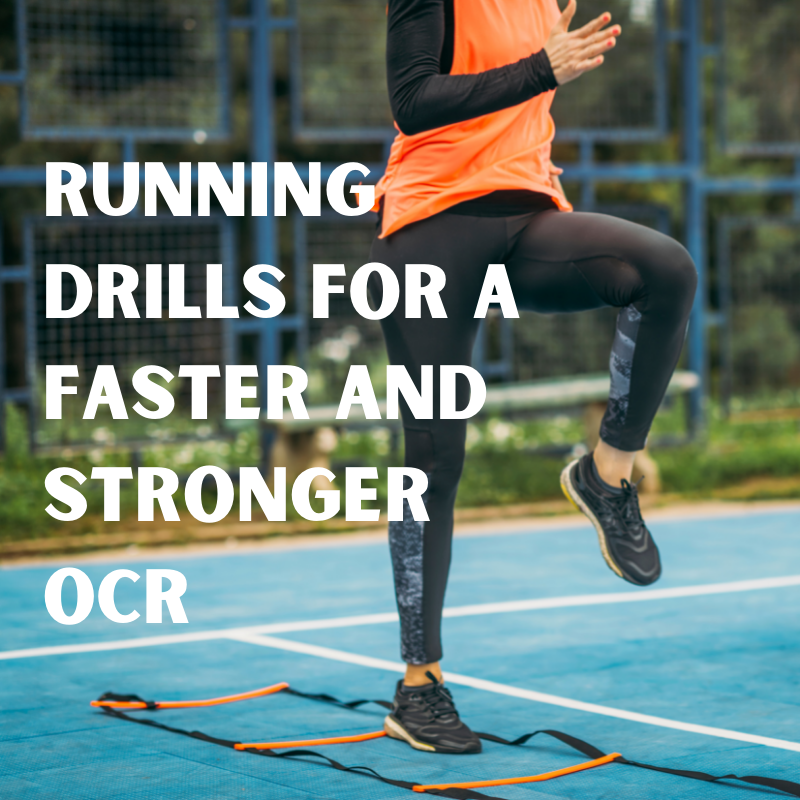Published June 16, 2021
By: Running 2 PR’s
Will incorporating running drills help you in an OCR?
The quick and short answer is yes! (Assuming you do them regularly and correctly!)
Think about the things you have to do in an obstacle course race: jump, crawl, land, run and pivot, plus more. Over the past couple of years, we have consistently incorporated drills as part of our warm-ups, cool downs, and overall training. But, we made a conscious decision to make it part of our training because the benefits far outweigh the annoyance of taking the extra time to warm-up or cool down. We feel that it has really helped us to be better prepared at keeping injuries away.
Runners in general stand to gain from a long list of benefits, including:
- improved strength
- speed
- balance
- coordination
- muscle firing
WHAT ARE THEY, EXACTLY?
Running drills are a series of movements that are repeated and often exaggerated. Incorporating them routinely can help improve running technique, which leads to overall improvements in running economy. (This means it makes it feel easier to run more efficiently while feeling like you’re putting in less effort!)
Runners who regularly incorporate running drills into training are less likely to experience injury, because their bodies are better able to quickly recruit the necessary muscles for the task at hand.
When a run gets tough, they are also more efficient than the runner who doesn’t work on proper form. Improving your running economy can be just as beneficial as improving your VO2 max when it comes to your overall time.
Running drills also train your body in muscle memory. When you do a drill with proper form, you engage muscles in movements that solidify proper form into muscle memory. As a running coach, I hear my athletes talk about feeling slow, heavy, or tired, yet they are putting down pretty great times and they still look strong when they’re running. This is because they practice running drills and work on form. It goes a long way, even when you feel like you’re moving like a turtle with a gallon of water on your back and lead for legs.
How Often Should You Do Drills?
If you are looking to increase speed and mobility, you may wish to consider incorporating them into your workouts a couple times per week.
Some runners (myself and what I encourage of my athletes) have recognized the benefits of completing running drills as a dynamic warm-up.
This basically means that if you decide to do them before every run, you are using the drills as a dynamic warm-up. Start with slower movement drills and then progress to the faster ones. This allows your body to gradually warm up.
There are a ton to choose from, but an example of some things I may include at some point in my warm-up prior to a run are:
- Slow jog
- Hamstring scoops
- High Knees
- Butt Kicks
- A-Skip
- B-Skip
(Note: my warm-up is totally different prior to a strength session because the goal is different.)
If you don’t know how to do some of these moves, Palmer Shape demonstrates nearly all of these exercises on YouTube. Here is his playlist for several of these dynamic warm-ups.
How Long or Far Should You Go?
Running drills should be done for approximately 20 meters, but the duration of drilling really depends on your objectives.
Time varies by individual, especially if you’re trying to warm up or cool down. Most people think they feel ready for activity after 5-10 minutes as a warm-up. If you are using this as a warm-up, I generally encourage closer to 10-15 minutes.
Ideally, drills done after a warm-up of a half-mile to a mile (or even two) will ensure muscles are warm and ready for exertion and an increase in range of motion.
If you are incorporating them after your run or as a standalone by themself, you may want to dedicate closer to 15 minutes to drills.
TYPES OF RUNNING DRILLS:
- A-Skips
- B-skips
- Kareoka
- High Knees
- Butt Kicks
- Side to side shuffle
- Backward running
- Straight leg bounds
Plyometrics are another kind of running drill you can incorporate, including agility ladder exercises.
There are numerous agility ladder moves that are beneficial to improving the quickness of your feet to develop speed, coordination, balance, and more.
- salsa dancing
- lateral side shuffle
- forward run
- double foot runs
- in and out
- diagonal hops
- high knees
Plyometrics can help improve your running performance if completed correctly and regularly. Incorporating a few plyometric exercises into your training routine will help your body become more efficient and powerful over time. This is especially beneficial when working on improving your power or speed when running.
If you have questions, drop them below! I’d be happy to answer and provide feedback. If you need help incorporating running drills into a custom run plan, I’m here to help with that too.
Download the Running 2 PRs FREE Couch to 5k


